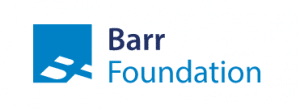Building Capacity to Serve Off-Track Students with the Barr Foundation
CompetencyWorks Blog
 This post has been updated with corrections.
This post has been updated with corrections.
Our country has been talking about ways to improve secondary education for at least thirty years: school-to-work, small schools, senior year transition, early college, project-based learning, service learning, online then blended learning, deeper learning, authentic learning, ninth grade transition, inquiry-based learning, community-based learning, portfolios, and exhibitions. In the last year, there has been a whole new push, starting with a White House convening on high schools and XQ. Now add the Barr Foundation’s courageous and insightful effort to build secondary school opportunities to better serve students who are missing the skills or credits they need to graduate, (i.e. they are “off track”).
One has to ask why hasn’t there been more progress or why these models and practices haven’t had more scaling power, more staying power. Of course our analysis at CompetencyWorks is that the traditional structure of education is going to be a significant challenge, if not a barrier, to any new educational strategies for the following reasons:
- Students are passed on even when they haven’t learned what they need to learn.
- Traditional scaffolding strategies usually fail to help students to actually learn and master the pre-requisite skills they need to engage in high school curriculum. We insist on grade level curriculum even when students need something else in order to succeed.
- Even with the highest engagement strategies, the traditional point systems and GPA only motivate the highest achievers.
- Students simply do not have enough information to know what they need to do to do better (and in many cases the teachers don’t know either) and don’t have the support they need.
- There is too much variability in how teachers determine proficiency.
There is a second reason – our districts have yet to take full responsibility for 100 percent of the students in their geographic regions. Students entering high school with elementary level skills, students with high mobility, youth in foster care, youth detained by the police, youth who have to work or take care of their families, youth who are pushed out, think the system is rigged against them, who don’t feel like they are getting what they need and decide to just get on with their lives – they are all likely to become “off track” at some point in their high school careers. They might be off track in skills, but not necessarily so. They will most certainly become off track in terms of the number of credits they need to graduate within four years. A quick peek at the data, and we can see that racial/class inequity is a prominent feature of how students become off track to graduation.
Continuous improvement doesn’t work unless you start with the goal of seeking 100 percent effectiveness. The analysis that leads to marginal corrections and new innovations requires constantly looking at the exceptions. Who isn’t learning, why, and what can we do differently? Who is leaving school, why, and what can we do differently to keep them engaged or re-enroll them?
Schools can’t be solely accountable. Accountability for ensuring access and engagement of all students, including off-track students, also rests in the hands of district leadership. We made some headway over the past twenty years with new polices related to multiple pathways and drop-out re-engagement. Yet, there is more to be done. Certainly competency education provides a structure to create the flexibility we need to better serve students who are off track (more on that in another post, but in the meantime you might want to check out Clearing the Path: Creating Innovation Space for Serving Over-age, Under-credited Students in Competency-based Pathways). Districts need to also be thinking about what are the options available for how students that have become off-track may be better served by schools designed to meet their unique needs with greater personalization, more intensive support, and more expansive flexibility.
Right now, I want to alert you to a new opportunity. The Barr Foundation’s Education Program has launched a new initiative to ensure higher levels of success for off-track high school students.
Within their strategic vision for a secondary education in New England is a focus on supporting students who have fallen behind in connecting to success. Their first effort will be “a multi-year initiative that will marshal critical resources, awareness, solutions, and opportunities to support one of New England’s most marginalized high school populations: students who are off track in the goal of graduating from high school and connecting to post-secondary success.”
Barr seeks partnerships with organizations and educators that are dedicated to “improving and/or creating a new generation of schools and programs to ensure higher levels of success for off-track students.” There are of course a few schools in the country that have learned how to serve any student regardless of their educational experience and pathways. Three examples are Building 21, ACE Leadership and Native American Community Academy (and stay tuned for DaVinci Schools New XQ school). I’m sure there are more, but I’ve found most of the charters and new schools seek to limit enrollment after tenth grade and most large high schools would prefer to send students to an alternative school rather than build new capacities within their own schools. Thus, Barr seeks to strengthen the type of school, such as Boston Day and Evening Academy of Apex (Diploma Plus) that excel in helping students that are off-track get back on track to graduation and college/career readiness.
The Barr Foundation’s first step is an invitation to potential partners to respond to a Request for Information to introduce your current work by October 21. That information will than inform a Request for Proposals (RFP) for the new initiative, currently planned for November. You’ll want to start by reading the excellent blog post by Leah Hamilton, Director of Education.